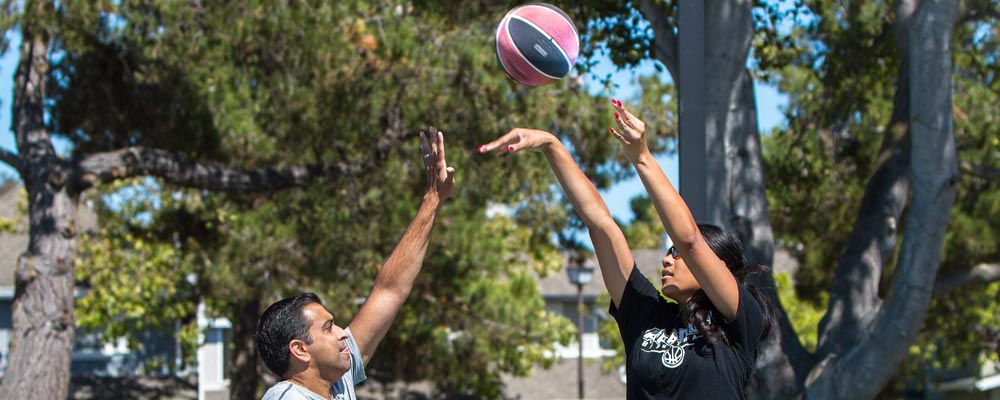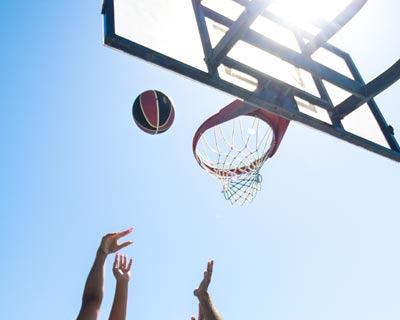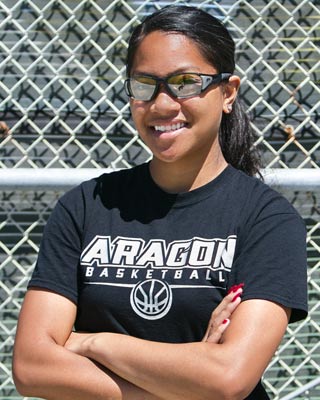
Rahul N. Khurana, MD, and Angellia Lilomaiava play a game of one-on-one basketball. Angellia credits Dr. Khurana for her fast-track to recovery following a retinal detachment.
When 15-year-old Angellia Lilomaiava got poked in the eye as she went up for a two-foot shot during a basketball tournament, she fell to the court in excruciating pain. But as she made her way back to the bench, she had no idea she just sustained an NBA-level injury that would threaten her vision and take her out of the game she loved for nearly four months.
“The pain was so bad that all I could do was lie on the court,” said Angellia, who plays for Aragon High School in San Mateo, Calif. “But even in that moment, it never occurred to me how long I’d be out. I was not thinking surgery. I thought I would be out for just a few days.”
At first, the emergency room physicians seemed to confirm her assumption. She was prescribed eyedrops to prevent infection and told to call her pediatrician on Monday for a referral. But a couple of days later Angellia started to see flashing lights before her eyes. This time, when her ophthalmologist, Rahul N. Khurana, MD, looked into her eyes, he knew he had to act fast. Angellia’s retina had detached from the back of her eye.
Race Against Time
A detached retina occurs when the retina, the light sensitive tissue, separates from the back of the eye. When detached, the cells of the retina will begin to die. This can lead to irreversible blindness so the retina needs to be reattached quickly by an ophthalmologist, a physician who specializes in medical and surgical eye care. By the time Angellia made it to Dr. Khurana’s office, she had already developed a blind spot in her peripheral vision.
"Dr. Khurana said he was going to get me back to looking through these eyes again." – Angellia Lilomaiava

Dr. Khurana explained to Angellia and her mother Nadine that she would need surgery right away. He would need to place a scleral buckle, which is a flexible band, around her eye to counteract the force pulling the retina out of place. He would then drain the fluid under the detached retina, allowing the retina to settle back into its normal position against the back wall of the eye.
“I started to get worried for my health and my game,” Angellia said. “But Dr. Khurana gave me the confidence, just by being the person he is. He was really encouraging. He likes basketball and his kids play. He told me he could heal it. It was a huge stress reliever.”
Dr. Khurana was a great comfort to her anxious mother, too. “I didn’t know the diagnosis was bad until I got home and looked it up,” said Nadine. “Dr. Khurana’s bedside manner was so reassuring. I knew everything would be OK.”
Just as he promised, surgery was a success. “Dr. Khurana said he was going to get me back to looking through these eyes again,” Angellia said. “And he did just that.”
Basketball a Leading Cause of Eye Injuries
A detached retina is more commonly associated with old age. The retina can become weaker and thinner with age. Tiny holes develop inside the retina which allow fluid (which is normally found between the retina and lens) to seep through. A buildup of fluid can cause the retina to start pulling away from the back of the eye.
"We need to make sports eye protection a public health issue." – Rahul N. Khurana, MD
But a detached retina can also occur after direct trauma to the eye from a blunt object. It is a common injury in boxers and basketball players. NBA player Amare Stoudemire suffered a detached retina while playing for the Phoenix Suns in 2008. In January, about the same time Angellia was hurt, former Virginia basketball player Akil Mitchell went up for a rebound while playing for the New Zealand Breakers, and was poked in the eye. The poke dislodged his left eye from its socket. A gruesome injury. But it wasn’t the first time it occurred. In 2006, Allen Ray’s eye popped out of his socket while playing a college basketball game for Villanova. Fortunately, for both players, their vision was saved by ophthalmologists.

Angellia sporting safety eyewear.
Most think of basketball as a non-contact sport. But when elbows and fingers fly under the rim, it’s common for injuries to occur. In fact, a 2016 study found that about 30,000 people in the U.S. go to emergency departments each year with sports-related eye injuries. Three sports accounted for almost half of all injuries: basketball, baseball and air/paintball guns.
The eye is a delicate organ, Dr. Khurana explained. When an elbow or a finger makes an impact, the eye absorbs all the force. “When the force is distributed over certain areas in the eye, tiny holes or a dialysis (a separation of the retina from its normal attachment in the eye) may develop. Over the course of a week or two, a retinal detachment can happen. That’s why it’s so important to see a doctor to be evaluated after an injury, so it can be caught and treated early.”
The finding that basketball is a leading cause of sports-related eye injuries was a wake-up call for Dr. Khurana, too. He has an 8-year-old son who’s just starting to play the game.
“This study highlights that we all need to be aware of the issue: parents, coaches, and children. We need to make sports eye protection a public health issue," Dr. Khurana said. “Unfortunately, unless you’ve had an accident it’s hard for people to understand the importance of wearing eye protection.”
Full Court Press for Advocacy
When Dr. Khurana gave Angellia the green light to return to the court nearly four months later, she was fired up and ready to go with a pair of sports eye protection glasses. Her teammates greeted her enthusiastically, shouting, “Oh my gosh you look like a super hero!”
“The glasses don’t hold me down or slow me down,” Angellia explained. “They don’t change how I play the game. I brought my same game, but even better. It was such a joy and a blessing to be back on the court, and to know I would be OK, and that I would be able to play the game that I love.”
Angellia has taken on the role of public advocate for sports eye protection with the same enthusiasm she brings to the game. Leading by example, she makes sure teammates, coaches and parents alike know that eye protection is a vital part of being prepared to play. Far from a hindrance, eye protection gives her the confidence to play hard.